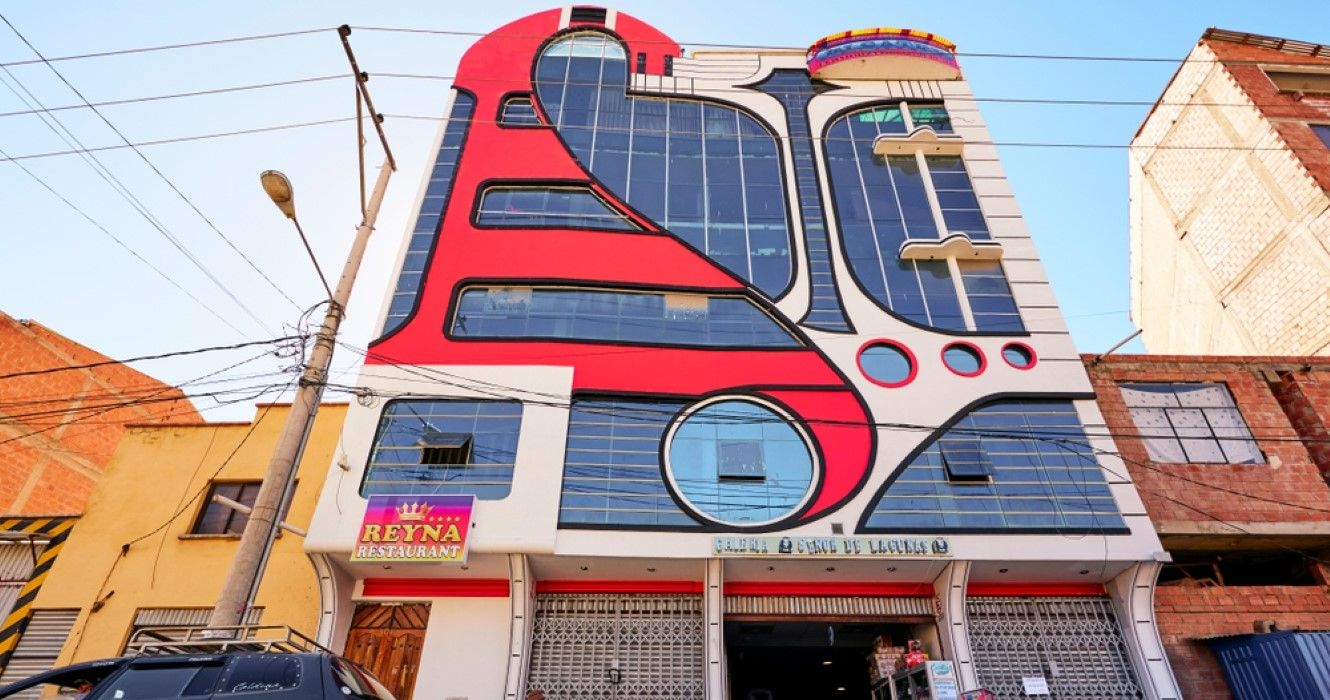At 4150 meters above sea level, El Alto is the highest city in Bolivia and the whole world - it’s where its name comes from, El Alto being Spanish for “The Heights.” A department of capital La Paz’s metropolitan sprawl, for decades, El Alto was known for the gray and nude brick tones of its working-class neighborhoods - but this was begun to change in the past few years. Headed by a construction worker and architect Freddy Mamani, a new type of architecture and aesthetic based on the region’s Aymara indigenous roots is painting the Altiplano with bold, bright colors and a new geometrical aesthetic made for the rising indigenous middle class and the city's development. This movement has caught the eye of the rest of Bolivia, as well as the rest of the world, and has been heating a slow simmer in the town's tourism, with people from different corners of the world looking to this “New Andean,” hyper-colorful sensibility.
Cholets: A New Andean Architecture That Is Changing El Alto
El Alto is a massive urban sprawl that developed organically as a metropolitan arm of La Paz, at the highest point of the Bolivian Altiplano, surrounded by the Andean Mountains. Most of the population in the town is indigenous - mostly Aymara and Quechua - sectors of society that were excluded from Bolivian society since colonial times. In the past decades, the financial and social mobility of these sectors changed rapidly, with a growing indigenous middle class gaining space and swelling El Alto into the most populous city and an important political hub in Bolivia.
In many ways, the New Andean architecture comes to represent many of the Andean indigenous cultures, mainly Aymara - characterized by the use of bright colors in their textiles and the cultural practice of seasonal parties - in ways that the ruling, minimalistic sensibilities of Western architecture could not.
El Alto is not a naturally colorful city; dirt roads, unfinished concrete and brick buildings, no trees or parks, and no exuberant Bolivian forests; it is predominantly rural migrants and a working-class town. But over time, in between the dusty roads and brick buildings, more and more tall buildings of loud, psychedelic geometry aid the painted murals of the town in giving it the contrast and color that exists in other aspects of its culture. These buildings are often called Cholets, the chalets of “cholos” - a pejorative term for the indigenous people of Bolivia, often reclaimed.
The Man Behind The Movement
The architect who kickstarted this architectural movement is Freddy Mamani Silvestre, a construction worker, engineer, and self-taught architect from the Altiplano countryside. Like the majority of the population in El Alto, Mamani is Aymara and cites the colors and geometric shapes of the textiles as an inspiration, as well as the architecture of the ancient Tiwanaku (also known as Tiahuanacu).
The ruins of the precolonial Tiwanaku civilization and the Temple of Kalasasaya, standing near El Alto in the Tiwanaku Municipality, are a big source of inspiration for Mamani, who visited the site often. In his Cholets, visual elements common to the architecture of Tiwanaku and significant to the Aymara can be identified, like the Andean cross, vipers as a sign of life, and circles that represent the eternal.
As more interest gathers around the New Andean style, more Cholets pop up in El Alto, many of which are not Freddy Mamani’s work. “I don’t mind the copies,” he says, “it just means the architecture is catching on.” Buildings marrying the Cholet style with brands like the Transformers and Iron Man make for fun sights amidst the city.
The Structure Of A Cholet
The “Cholet” buildings usually follow the structure of a storefront or business on the first floor, a ballroom and event room on the second floor, which are often rented for weddings, anniversaries, and all sorts of celebrations, and apartments on the top floors and the actual chalet style cholets as a sort of penthouse, where the owners live. The constructions are usually blessed during the process, and offerings to Pachamama are burned to ensure prosperity for the buildings and their owners.
The new style of architecture has generated plenty of discussion in Bolivian academic circles; some dismiss it as mere kitsch decoration, but for others, Cholet’s and Mamani’s New Andean architecture is a break from colonial ideals of architecture, a new aesthetic by and for the Andean Altiplano created not by copying ancient visual elements, but by creating something that marries ancient traditions and the modern lives, visions, needs, and customs of the Andean people.
Take An Architectural Tour Of El Alto To Visit The Cholets
The New Andean ideas have made an impact in more than urban, architectural, or academic circles: El Alto’s tourism has been enjoying the after-effect of this colorful movement. With the popularity and interest in the Cholet worldwide - news reports have investigated it steadily, and Mamani, in particular, has exhibited projects and dioramas of his work in several cities around the world - many tourists seek El Alto for a glimpse at these kaleidoscopic Andean buildings, in architectural tourism.
Today, El Alto has specific architectural tours that guide visitors around town.
- Duration: Around 3 hours
- Rates: USD 26 per adult
- What's Included: Will take travelers through the city in cable cars and street walks, explaining the history and context of the cholets, and entering a few of the multicolored ballrooms
The Havana B&B is also an interesting option to stay inside a Cholet in El Alto for those who want an even more in-depth experience.
- Prices Starting At: USD 55 per room
- Why You Should Book: Havana B&B is a chance for visitors to stay inside a cholet.

